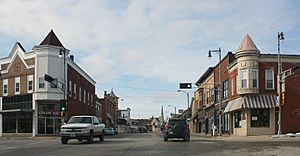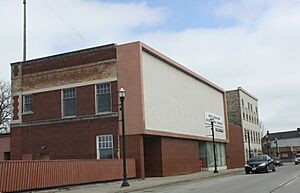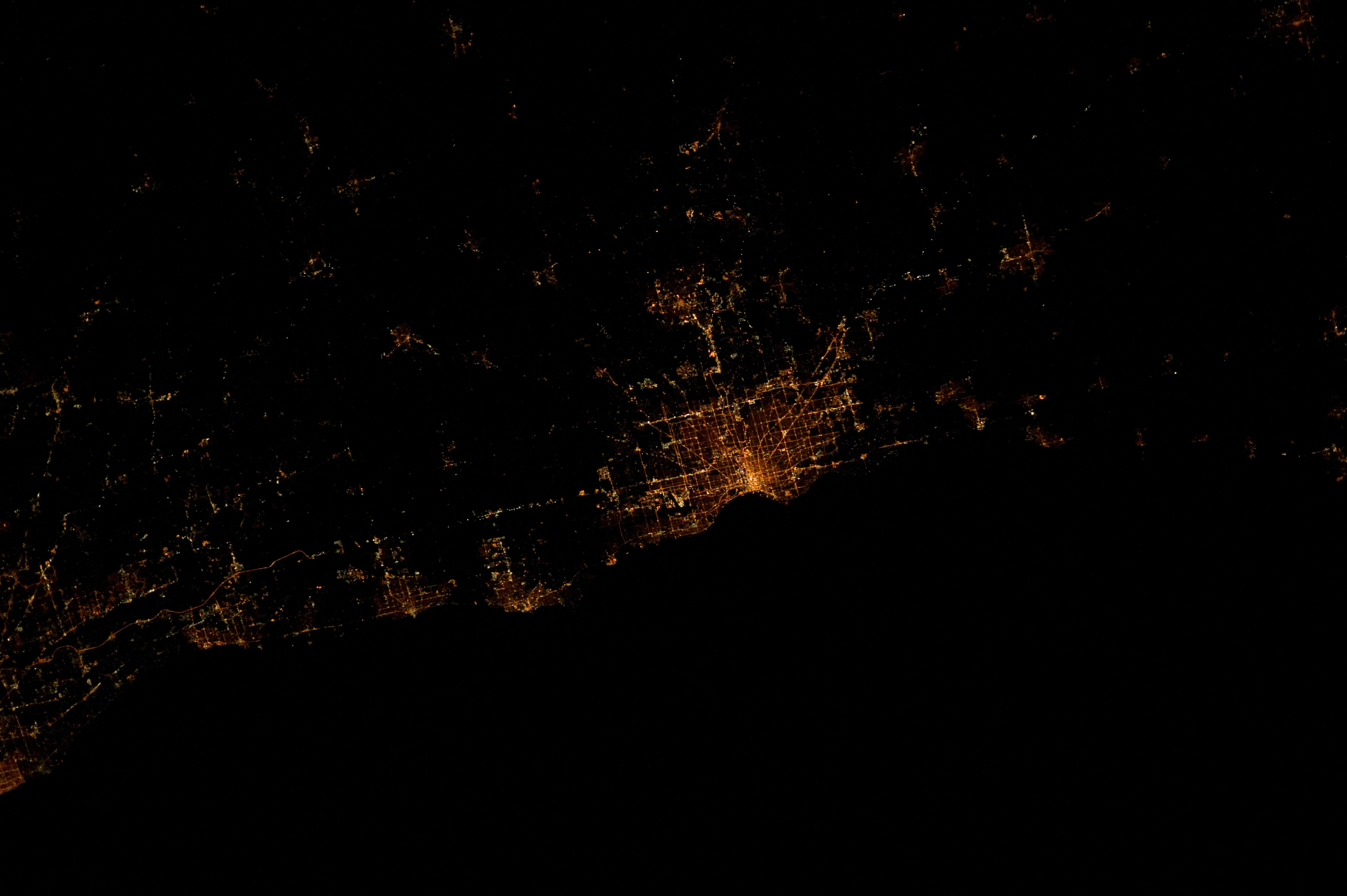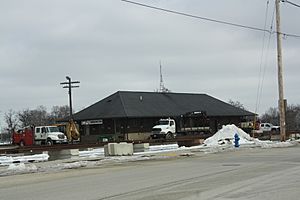Burlington, Wisconsin facts for kids
Quick facts for kids
Burlington
|
|
|---|---|
|
City
|
|

Downtown Burlington
|
|
| Nicknames:
Chocolate City, U.S.A.
|
|
| Motto(s):
The town with Tall Tales
|
|

Location of Burlington in Racine and Walworth counties, Wisconsin
|
|
| Country | United States |
| State | |
| County | Racine, Walworth |
| Incorporated (village) | 1886 |
| Incorporated (city) | 1900 |
| Named for | Burlington, Vermont |
| Government | |
| • Type | Mayor–council |
| Area | |
| • Total | 7.97 sq mi (20.64 km2) |
| • Land | 7.71 sq mi (19.98 km2) |
| • Water | 0.25 sq mi (0.65 km2) 2.98% |
| Population
(2020)
|
|
| • Total | 11,047 |
| • Density | 1,423.20/sq mi (549.48/km2) |
| Time zone | UTC-6 (CST) |
| • Summer (DST) | UTC-5 (CDT) |
| ZIP Code |
53105
|
| Area code(s) | 262 |
| FIPS code | 55-11200 |
Burlington is a city in Wisconsin, located mostly in Racine County and partly in Walworth County. It had a population of 11,047 people in 2020. Burlington is often called "Chocolate City, U.S.A." because of its famous chocolate factory.
Contents
History of Burlington
Early Days and First Settlers
Before Europeans arrived, Native American mounds were built near where Burlington is today. Around 1830, a small Potawatomi village existed nearby.
The first Europeans came to the area in 1799. They were French explorers and missionaries. They traveled from the Root River to the Fox River.
The first permanent European settlers were Moses Smith and William Whiting. They marked their claim to the land on December 15, 1835. They built a cabin on the east side of the Fox River. More settlers arrived in 1836, mostly from New England. They first named their settlement Foxville.
How Burlington Got Its Name
In 1836, the people of Foxville decided to change the name. They chose "Burlington" after the city Burlington, Vermont. The name Foxville was officially changed on July 15, 1839.
On July 3, 1836, Foxville became part of the new Wisconsin Territory. It was in Milwaukee County, which later split. Foxville then became part of Racine County. The first post office opened on March 21, 1837. Moses Smith, one of the founders, was the first postmaster.
In 1837, a sawmill and a dam were built on the Fox River. This helped the settlement grow.
Growth and Development
In 1838, the area including Foxville became Rochester township. Then, in 1839, Burlington township was created.
Many early settlers came from New England. They brought their traditions, like supporting education. They built schools and valued learning. They were also against slavery.
From 1844 to 1850, a religious group called the Church of Jesus Christ of Latter Day Saints (Strangite) had its main center in nearby Voree. Their leader, James Strang, was buried in Burlington. His church still has a group in Voree today.
Burlington officially became a village in 1886. It became a city in 1900.
Geography and Climate
Where is Burlington Located?
Burlington covers about 7.73 square miles (20.02 square kilometers). Most of this area is land, and a small part is water.
The city is located at coordinates 42°40′40″N 88°16′41″W.
Weather in Burlington
Burlington experiences a range of temperatures throughout the year. Summers are warm, and winters are cold with snow.
| Climate data for Burlington, Wisconsin (1991–2020 normals, extremes 1951–present) | |||||||||||||
|---|---|---|---|---|---|---|---|---|---|---|---|---|---|
| Month | Jan | Feb | Mar | Apr | May | Jun | Jul | Aug | Sep | Oct | Nov | Dec | Year |
| Record high °F (°C) | 60 (16) |
67 (19) |
82 (28) |
90 (32) |
94 (34) |
102 (39) |
105 (41) |
102 (39) |
101 (38) |
90 (32) |
76 (24) |
67 (19) |
105 (41) |
| Mean maximum °F (°C) | 48.7 (9.3) |
51.5 (10.8) |
66.8 (19.3) |
78.0 (25.6) |
85.7 (29.8) |
90.6 (32.6) |
91.7 (33.2) |
90.4 (32.4) |
87.2 (30.7) |
79.9 (26.6) |
64.9 (18.3) |
52.0 (11.1) |
94.1 (34.5) |
| Mean daily maximum °F (°C) | 27.7 (−2.4) |
31.4 (−0.3) |
42.7 (5.9) |
55.7 (13.2) |
67.1 (19.5) |
76.9 (24.9) |
81.0 (27.2) |
79.5 (26.4) |
72.9 (22.7) |
60.0 (15.6) |
45.2 (7.3) |
32.9 (0.5) |
56.1 (13.4) |
| Daily mean °F (°C) | 19.6 (−6.9) |
22.7 (−5.2) |
33.1 (0.6) |
44.1 (6.7) |
55.8 (13.2) |
65.8 (18.8) |
70.2 (21.2) |
68.6 (20.3) |
61.2 (16.2) |
49.3 (9.6) |
36.4 (2.4) |
25.4 (−3.7) |
46.1 (7.8) |
| Mean daily minimum °F (°C) | 11.5 (−11.4) |
14.0 (−10.0) |
23.4 (−4.8) |
33.7 (0.9) |
44.4 (6.9) |
54.7 (12.6) |
59.3 (15.2) |
57.7 (14.3) |
49.5 (9.7) |
38.6 (3.7) |
27.6 (−2.4) |
17.9 (−7.8) |
36.0 (2.2) |
| Mean minimum °F (°C) | −10.1 (−23.4) |
−5.6 (−20.9) |
5.5 (−14.7) |
21.4 (−5.9) |
31.1 (−0.5) |
41.9 (5.5) |
48.5 (9.2) |
47.8 (8.8) |
36.2 (2.3) |
25.2 (−3.8) |
12.7 (−10.7) |
−2.0 (−18.9) |
−13.9 (−25.5) |
| Record low °F (°C) | −27 (−33) |
−27 (−33) |
−15 (−26) |
3 (−16) |
22 (−6) |
32 (0) |
39 (4) |
39 (4) |
23 (−5) |
15 (−9) |
−9 (−23) |
−18 (−28) |
−27 (−33) |
| Average precipitation inches (mm) | 1.82 (46) |
1.76 (45) |
2.08 (53) |
3.59 (91) |
3.96 (101) |
4.51 (115) |
3.59 (91) |
3.55 (90) |
3.46 (88) |
2.75 (70) |
2.38 (60) |
1.88 (48) |
35.33 (897) |
| Average snowfall inches (cm) | 12.1 (31) |
9.7 (25) |
4.9 (12) |
1.1 (2.8) |
0.0 (0.0) |
0.0 (0.0) |
0.0 (0.0) |
0.0 (0.0) |
0.0 (0.0) |
0.0 (0.0) |
2.2 (5.6) |
7.7 (20) |
37.7 (96) |
| Average precipitation days (≥ 0.01 in) | 9.0 | 7.5 | 9.0 | 11.5 | 12.3 | 10.9 | 9.1 | 9.9 | 8.9 | 9.7 | 9.0 | 8.9 | 115.7 |
| Average snowy days (≥ 0.1 in) | 6.0 | 4.5 | 2.3 | 0.7 | 0.0 | 0.0 | 0.0 | 0.0 | 0.0 | 0.0 | 1.3 | 4.3 | 19.1 |
| Source: NOAA | |||||||||||||
People of Burlington
Population Changes Over Time
The population of Burlington has grown steadily over the years. In 1860, there were 993 people. By 2020, the population had reached 11,047.
| Historical population | |||
|---|---|---|---|
| Census | Pop. | %± | |
| 1860 | 993 | — | |
| 1870 | 1,589 | 60.0% | |
| 1880 | 1,611 | 1.4% | |
| 1890 | 2,043 | 26.8% | |
| 1900 | 2,256 | 10.4% | |
| 1910 | 3,212 | 42.4% | |
| 1920 | 3,626 | 12.9% | |
| 1930 | 4,114 | 13.5% | |
| 1940 | 4,414 | 7.3% | |
| 1950 | 4,780 | 8.3% | |
| 1960 | 5,856 | 22.5% | |
| 1970 | 7,479 | 27.7% | |
| 1980 | 8,385 | 12.1% | |
| 1990 | 8,855 | 5.6% | |
| 2000 | 9,936 | 12.2% | |
| 2010 | 10,464 | 5.3% | |
| 2020 | 11,047 | 5.6% | |
| Source: U.S. Census | |||
Who Lives in Burlington? (2010 Census)
In 2010, Burlington had 10,464 people. There were 4,240 households. The city had about 1,395 people per square mile.
Most residents (92.8%) were White. Other groups included African American (0.9%), Native American (0.4%), and Asian (1.1%). About 8.6% of the population was Hispanic or Latino.
About 32.8% of households had children under 18. The average household had 2.43 people. The average family had 3.03 people.
The average age in Burlington was 38.6 years. About 25.4% of residents were under 18. About 15% were 65 or older.
Economy and Businesses
Local Breweries
Burlington is home to several breweries. These include:
- Burlington Brewing Company
- Van Merritt Brewing Company
- Wisconsin Brewing Company
- Finke and Uhen Brewery
Education in Burlington
History of Schools
The first school classes in Burlington started in 1838. The first schoolhouse was built in 1839.
In 1857, the Burlington Union School District was formed. A schoolhouse was built for the district in 1858-1859. This building is now called Lincoln School. It is used as the main office for the Burlington Area School District.
Schools Today
The Burlington Area School District serves the city. It has eight schools, with six located in Burlington.
- Elementary Schools:
- Cooper Elementary
- Waller Elementary
- Winkler Elementary
- Lyons Center
- Middle Schools:
- Karcher Middle School
- Dyer Intermediate
A campus of the Gateway Technical College is also in Burlington.
Private Schools
Burlington also has private and religious schools:
- Burlington Catholic School
- St. John's Lutheran School
- Catholic Central High School
The Sacred Heart Retreat Center is also located here.
Culture and Fun
Nicknames and Festivals
Burlington is known as "Chocolate City, U.S.A." This is because a Nestlé chocolate factory was built there in 1966. The city also hosts an annual Chocolate Fest on Memorial Day weekend.
Since 1929, Burlington has been the home of the Burlington Liars' Club.
Things to Do
- Recreation: People enjoy fishing on Echo Lake and the Fox River.
- Sports:
- Burlington Little League has won many state championships.
- The Burlington Blue Devils are a semi-pro football team.
- The Burlington Barons are a semi-pro baseball team. They play at Beaumont Field.
- Places to Visit:
- The community of Voree is just outside the city.
- The Malt House Theater is home to the Haylofters, a community theater group. They have been performing since 1932.
Media in Burlington
Newspapers
The first newspaper in the area was the Voree Herald, started in 1846. It was for a religious group.
The first newspaper for everyone in Burlington was the Weekly Burlington Gazette, started in 1858.
Today, the weekly Burlington Standard Press is published in Burlington. You can also find daily newspapers like the Racine Journal Times and Milwaukee Journal Sentinel.
Radio and Television
WBSD (89.1 FM) is a high school radio station run by students at Burlington High School. Other radio stations like WIIL (95.1 FM) and WLKG (96.1 FM) also serve the area.
WIN Media, Inc. (formerly Win-TV) started around 1989. It produces local news and sports for Southeastern Wisconsin.
Getting Around Burlington
Major Roads
Several highways pass through or near Burlington:
- Interstate Highways:
- U.S. Highways:
- Wisconsin Highways:
- County Highways:
Railroads
The first railroad came through Burlington in 1855. It was built by the Racine, Janesville and Mississippi Railroad Company. This line later became part of the Milwaukee Road.
Another railroad line was built in 1885–1886 by the Wisconsin Central Railroad. This line is now operated by the Canadian National Railway.
Airport
The Burlington Municipal Airport (KBUU) serves Burlington and nearby towns.
Notable people
- Alma M. Aldrich, Wisconsin State Representative
- Maurice L. Ayers, politician
- Caleb P. Barns, lawyer
- Charles Edward Barns, writer
- Ginger Beaumont, professional baseball player
- Frank Cannella, sometimes referred to as the "father of the infomercial" industry
- William Everett Chipman, state senator
- Henry Allen Cooper, Congressman from Wisconsin's 1st congressional district
- Leander F. Frisby, lawyer
- Ed Garvey, lawyer, politician, executive director of the National Football League Players Association
- Jared Hornbeek, bassist/musician of alternative rock band, The Unlikely Candidates
- Gregory Itzin, the actor who portrays fictional president Charles Logan of TV's 24, was a former resident
- Kelly Kahl, television executive
- Nettie Karcher, first woman attorney in Burlington and all of Racine County, 1915-1969
- Bill Kazmaier, three-time World's Strongest Man winner; ESPN commentator on World's Strongest Man broadcasts
- John Longstreth, drummer of the technical death metal band Origin
- William P. Lyon, Justice of the Wisconsin Supreme Court
- Paul Miller, MLB player
- George C. Mathews, member of first Securities and Exchange Commission
- Ernst Merton, Wisconsin State Senator and lawyer
- Cloyd A. Porter, Wisconsin State Representative
- Edward F. Rakow, Wisconsin State Representative
- Anthony B. Rewald, legislator
- Davis C. Rohr, U.S. Air Force Major General
- Tony Romo, quarterback of the Dallas Cowboys, attended Burlington High School
- Braggo Roth, MLB player
- Frank Roth, MLB player
- Francis Reuschlein, Wisconsin State Representative
- Henry Schadeberg, U.S. Representative
- Judith D. Schulz, tops Expert for "My Summer Story" (sequel to A Christmas Story).
- James T. Schuerman, Roman Catholic bishop
- Bob Steele, MLB player
- James Strang, founded the Church of Jesus Christ of Latter Day Saints (Strangite) from Voree; lawyer and member of the Michigan House of Representatives
- Chris Vos, singer/musician of Grammy-nominated alternative rock band, The Record Company
- Robin Vos, Wisconsin State Representative and 75th Speaker of the Wisconsin State Assembly
- Mary Wagner, legislator and jurist
Images for kids
See also
 In Spanish: Burlington (Wisconsin) para niños
In Spanish: Burlington (Wisconsin) para niños








